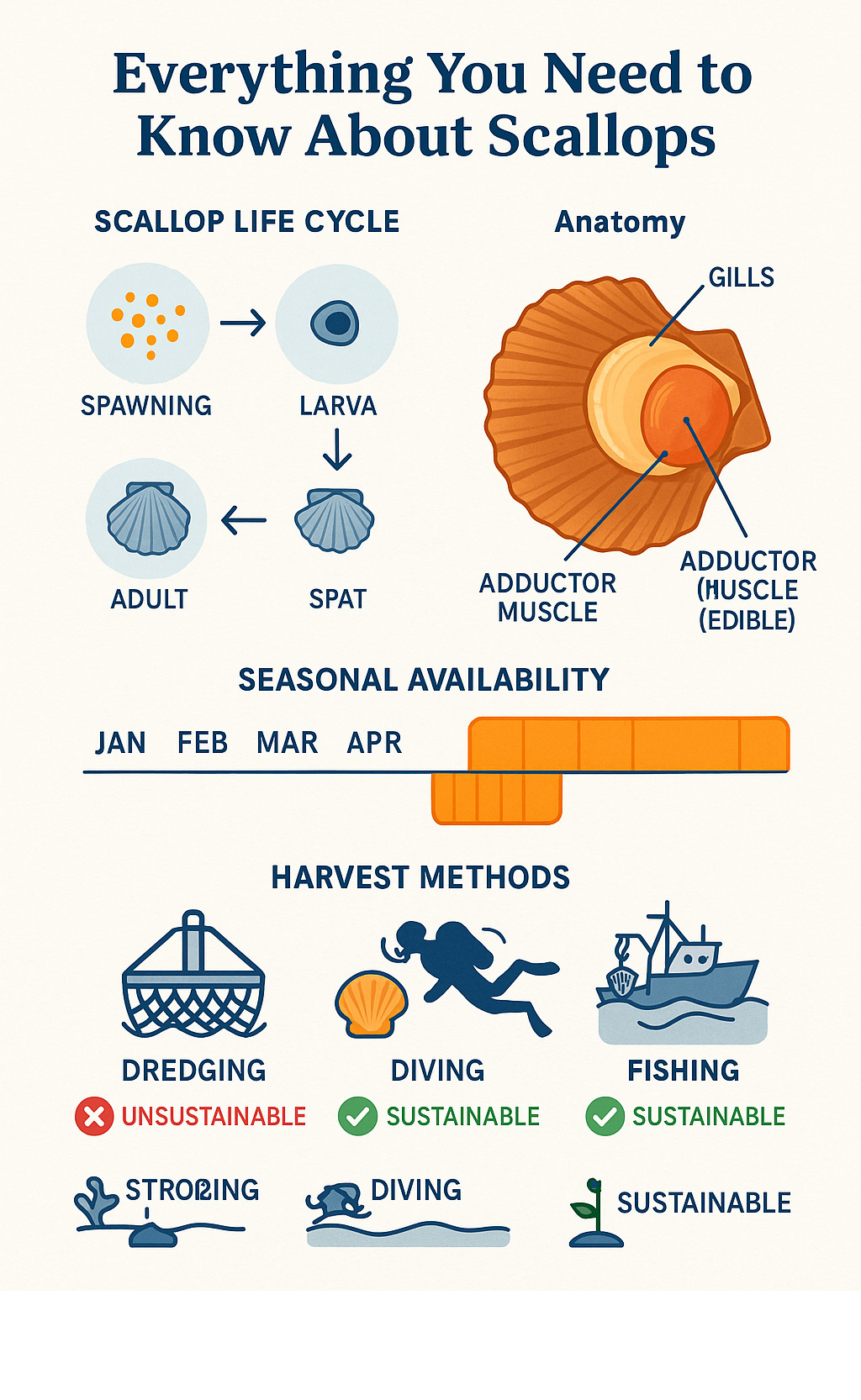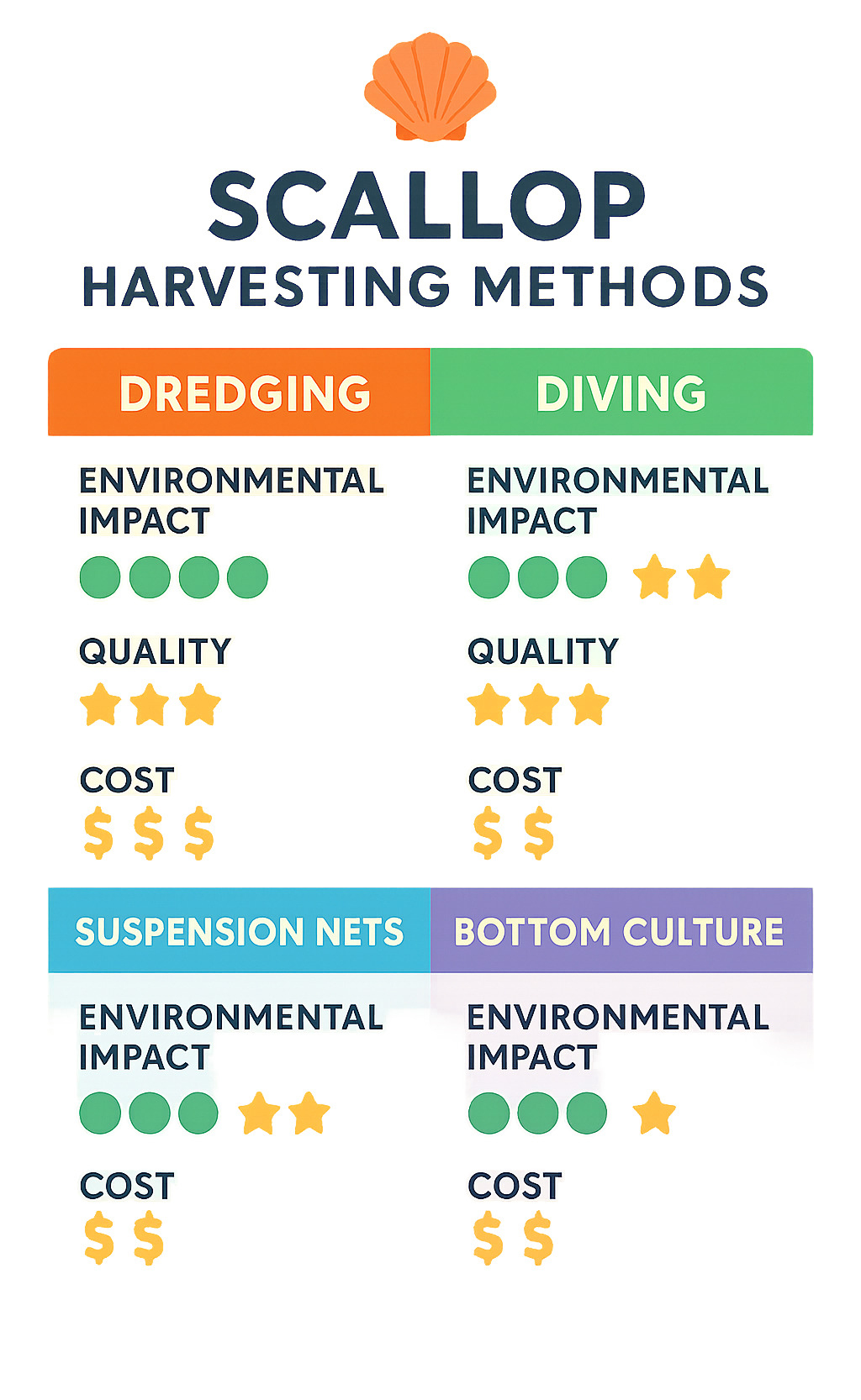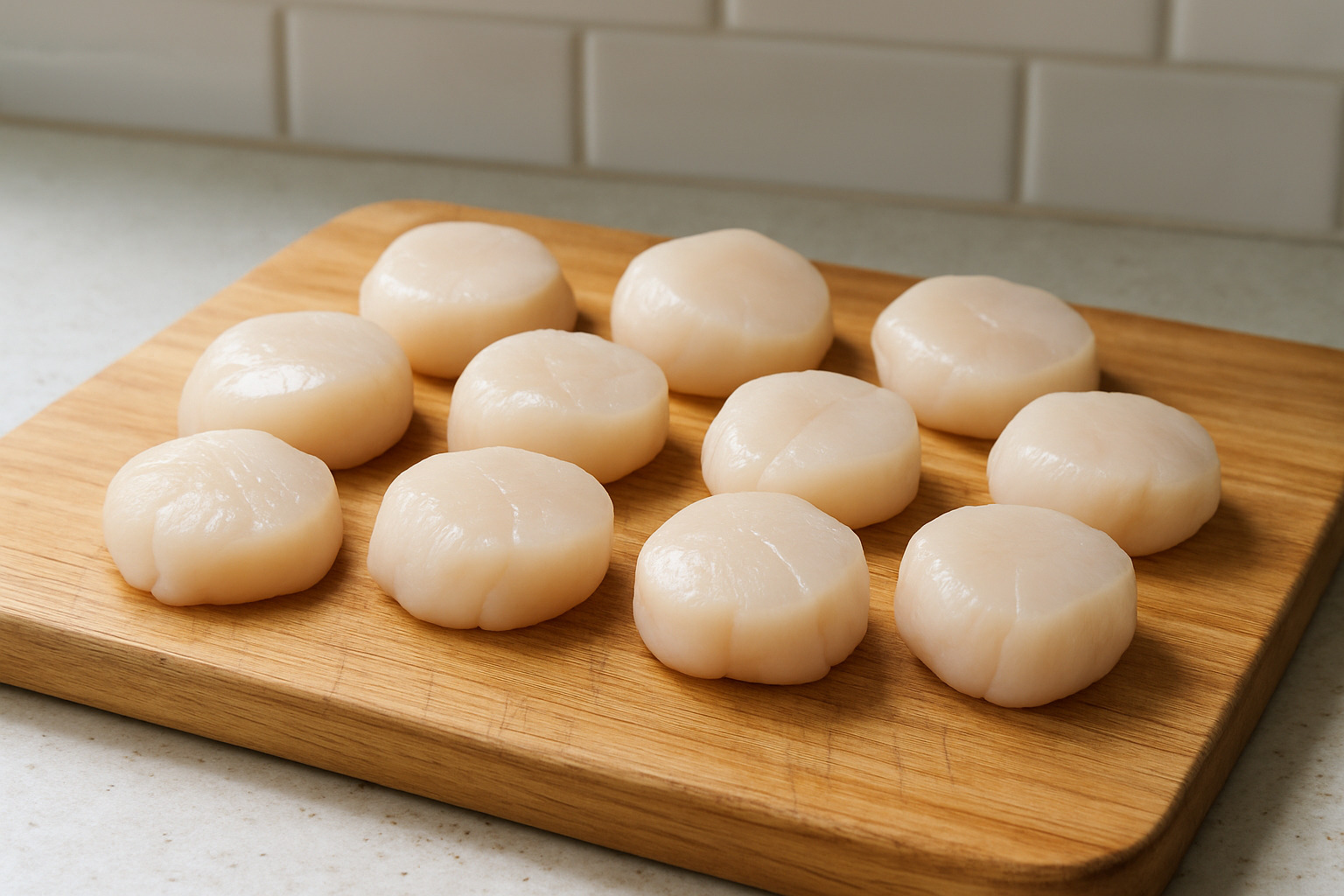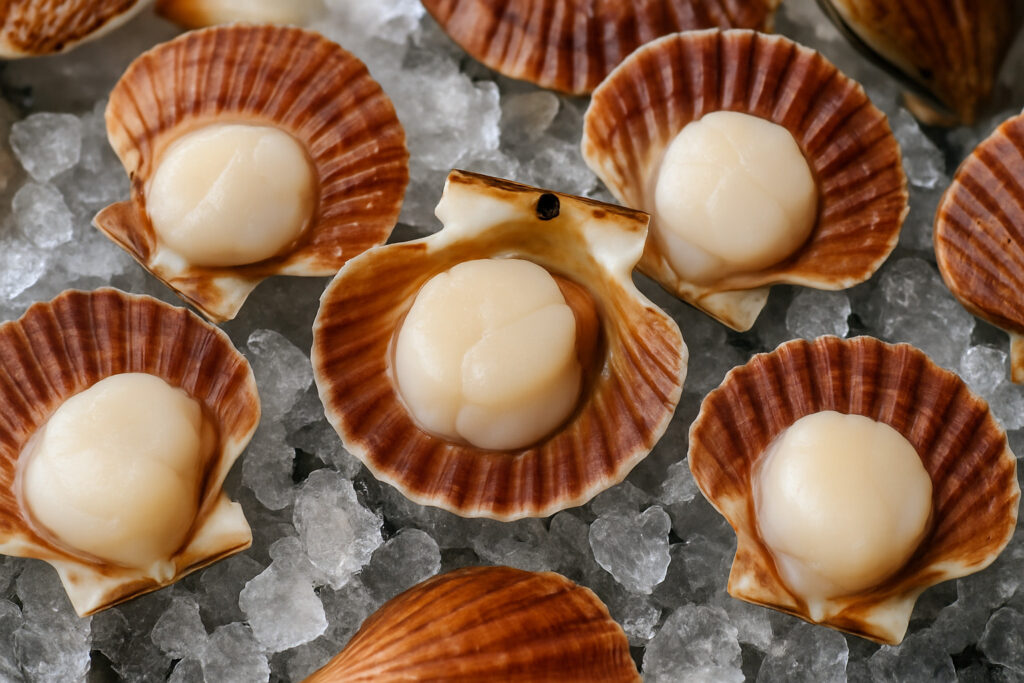Why Scallops Are the Ocean’s Hidden Culinary Gem
Scallops are bivalve mollusks in the Pectinidae family, prized for their sweet, delicate adductor muscle that delivers restaurant-quality elegance to any plate. Unlike their sedentary shellfish cousins, these remarkable creatures can actually swim through the ocean using jet propulsion.
Quick Scallop Facts:
- What they are: Marine bivalves with fan-shaped shells
- Main types: Sea scallops (large, 1-2 inches) and bay scallops (small, 0.5 inches)
- Taste: Sweet, buttery, slightly briny – never fishy when fresh
- Nutrition: High protein (18g per 100g), low fat, rich in omega-3s
- Best cooking method: High-heat sear for 2 minutes per side
- Sustainability: Look for MSC-certified or diver-harvested options
For culinary travelers seeking authentic experiences, scallops represent the perfect intersection of sustainability, nutrition, and gastronomic trip. From the cold waters off Canada’s North Atlantic to the shallow bays of New England, these “sea candies” have captivated chefs and food lovers for centuries.
What makes scallops truly special goes beyond their incredible taste. They’re one of the few bivalves capable of rapid movement, equipped with up to 200 tiny mirror-based eyes, and have served as symbols of pilgrimage and rebirth throughout history. Whether you’re planning your next food-focused journey or simply want to master this premium protein at home, understanding everything you need to know about scallops opens doors to some of the world’s most memorable dining experiences.

What Makes Scallops Unique?
When you think about seafood, scallops probably don’t come to mind as Olympic swimmers. Yet these remarkable creatures can actually zip through the ocean using their own built-in jet propulsion system! The Pectinidae family contains over 300 species, making it one of the largest marine bivalve families – and definitely the most athletic.
What truly sets scallops apart from their sedentary cousins like clams and oysters is their incredible mobility. While most shellfish spend their lives glued to rocks or buried in sand, scallops are free-living travelers. They achieve their famous swimming ability through rapid shell clapping that creates powerful water jets.
But here’s where things get really wild – scallops have up to 200 tiny eyes arranged like pearls along their shell edges. These aren’t just simple light detectors either. Scientific research on scallop eyesight reveals they’re sophisticated visual systems that use guanine crystals instead of traditional lenses to focus and reflect light. Imagine having 200 tiny mirrors helping you spot danger and steer the ocean floor!
Female scallops are incredibly prolific mothers, capable of producing hundreds of millions of eggs per year. Some species live over 20 years, while others like the Atlantic bay scallop live fast and die young. This amazing reproductive capacity has made them both abundant in the wild and perfect candidates for sustainable aquaculture.
The Anatomy of a Scallop
The scallop’s distinctive fan-shaped shell is actually two separate pieces – called valves – connected by a flexible hinge. The upper valve tends to be flatter, while the lower valve is more curved and often more colorful. What we love to eat is that large adductor muscle in the center – the powerful, sweet-tasting cylinder that opens and closes those shells.
In large sea scallops, this muscle can reach up to 2 inches in diameter. It’s incredibly dense and meaty, with a texture that’s both tender and satisfying when cooked properly.
Many scallops also have a bright orange or pink section called the “coral” or roe – that’s actually their reproductive organ. While most North American markets remove this part, European chefs consider it a delicacy that adds a rich, slightly sweet flavor to dishes.
Scallops in Culture & History
The scallop shell has been making appearances in human culture for thousands of years, and not just on dinner plates! Most famously, it became the official badge of medieval pilgrims walking the Camino de Santiago to the shrine of Saint James in Spain.
Legend tells of Saint James rescuing a knight who emerged from the sea completely covered in scallop shells. This miraculous story cemented the connection between these beautiful mollusks and spiritual journeys. Even today, you’ll see the “Shell of Saint James” marking the famous pilgrimage route.
The symbolic power of scallops spread far beyond religious contexts. Botticelli’s “The Birth of Venus” immortalized the scallop shell as a symbol of beauty and rebirth – that iconic image of Venus rising from a giant shell is actually a scallop! The fan shape also became popular in heraldry, appearing on noble family crests throughout Europe.
Types, Sourcing & Sustainability of Scallops
When you’re exploring scallops, understanding the different types and how they’re sourced makes all the difference in your culinary trips. The two stars of North American markets are sea scallops and bay scallops, each bringing their own personality to the plate.
Sea scallops are the heavyweight champions, often graded by size using terms like U-10 or U-15 – meaning you’ll get under 10 or 15 scallops per pound. The bigger they are, the more you’ll pay, but these giants give you that dramatic restaurant presentation and are much easier to cook without overdoing it.
Bay scallops, on the other hand, are the sweet little gems that pack incredible flavor into their dime-sized packages. They’re naturally sweeter and more delicate than their ocean cousins, making them perfect for lighter preparations.
The choice between wild vs farmed scallops isn’t just about taste – it’s about supporting healthy oceans too. Wild Atlantic sea scallops from the waters off the U.S. northeast and eastern Canada represent some of the world’s most successful fishery management stories. Meanwhile, responsible scallop farming using suspension nets offers an environmentally friendly alternative that doesn’t disturb the seafloor.
Look for MSC certification when you’re shopping – it’s your guarantee that these scallops come from well-managed fisheries. Canadian North Atlantic scallops are particularly impressive because they’re often flash-frozen at sea within an hour of harvest, locking in peak freshness better than many “fresh” options that spend days traveling to market.
The sustainable dining trend has made diver scallops increasingly popular. These hand-harvested beauties cost more, but they’re individually selected at perfect ripeness with zero environmental impact. For more insights into making sustainable choices, check out our guide to locally sourced ingredients.
Sea Scallops vs Bay Scallops — The Core Differences
| Characteristic | Sea Scallops | Bay Scallops |
|---|---|---|
| Size | 1-2 inches diameter | 0.5 inches (dime-sized) |
| Habitat | Deep, cold ocean waters | Shallow bays and estuaries |
| Harvest Season | Year-round | Fall through spring |
| Sweetness Level | Mildly sweet, meaty | Very sweet, delicate |
| Best Cooking Methods | Pan-searing, grilling | Soups, pasta, light sautés |
| Price Range | Higher (especially U-10) | More affordable |
| Texture | Firm, substantial | Tender, delicate |
Sea scallops love the deep, cold waters of the North Atlantic where they can grow to impressive sizes. Their substantial, meaty texture makes them perfect for high-heat cooking that creates those gorgeous golden crusts while keeping the inside tender and sweet.
Bay scallops prefer the warmer, shallower waters along the East Coast. These little sweethearts have had a rough history – their populations were nearly wiped out by eelgrass blight in the 1930s and they’ve struggled with overfishing ever since. That’s why choosing sustainably sourced bay scallops is so important.
How Scallops Are Harvested Responsibly
The way scallops are harvested makes a huge difference for both ocean health and your dining experience. Traditional dredging involves dragging nets across the seafloor, which has improved dramatically with better equipment and smart area management to protect sensitive habitats.
Hand-harvest by divers represents the gold standard of sustainability. Diver scallops are individually selected at peak condition and handled with care that machines simply can’t match. Yes, they cost more, but the quality and environmental benefits make them worth every penny.
Aquaculture advances have revolutionized scallop farming, especially with suspension-net systems that don’t damage seafloor habitats. The real game-changer has been flash-freeze at sea technology. This means frozen scallops can actually be fresher than “fresh” ones that have been sitting around for days. Quota management and habitat protection programs ensure that scallop populations stay healthy for future generations of food lovers to enjoy.

Selecting, Storing & Prepping Scallops
When it comes to everything you need to know about scallops, selecting the right ones at the market is absolutely crucial for cooking success. The difference between a restaurant-quality dish and a disappointing meal often comes down to this single decision.
The most important distinction you’ll encounter is between dry-packed and wet-packed scallops. Think of dry-packed scallops as the premium option – they contain no added water or chemical preservatives like sodium tripolyphosphate. These beauties have a natural, slightly sticky texture that feels right in your hand. When you cook them, they’ll reward you with that gorgeous golden crust that makes your mouth water.
Wet-packed scallops, on the other hand, are treated with water and chemicals to make them last longer and weigh more. While they’re easier on your wallet, they’re harder on your cooking dreams. All that extra moisture means they’ll steam rather than sear, leaving you with pale, rubbery results instead of the caramelized perfection you’re after.
If you’re stuck with wet-packed scallops, don’t panic. Soak them in cold water with a squeeze of lemon juice and a pinch of salt for 30 minutes. This little trick helps draw out some of that excess moisture and gives you a fighting chance at proper browning.
Fresh versus frozen is another key consideration. High-quality frozen scallops that were flash-frozen at sea often beat “fresh” ones that have been sitting around for days. The color test is your friend here – look for scallops that are creamy white to slightly beige, never bright white (which screams chemical treatment) or grayish (which whispers spoilage).
Give them a gentle press too. Fresh scallops should feel firm and slightly springy, bouncing back when you touch them. And always trust your nose – they should smell like a clean ocean breeze, not like yesterday’s fish market.

For storage, treat fresh scallops like the delicate treasures they are. Keep them nestled on ice in your refrigerator and plan to use them within 1-2 days maximum. If you need to freeze them, they’ll keep for up to 3 months, though the texture might suffer a bit.
When thawing frozen scallops, patience pays off. Let them defrost slowly in the refrigerator overnight for best results. In a hurry? The cold water method works too – just submerge them in cold water, changing the water every 30 minutes until they’re completely thawed.
How to Spot Top-Quality Scallops at Market
Reading labels becomes an art form when you’re hunting for the best scallops. Look for magical words like “dry-packed,” “chemical-free,” or “all-natural” – these are your golden tickets to cooking success.
Those mysterious numbers like U-10 or U-12 tell you about size – they mean “under 10” or “under 12” scallops per pound. The smaller the number, the bigger the individual scallop, and typically the higher the price.
Here’s something that might surprise you – fake scallops are actually a thing. Some unscrupulous sellers cut shark meat with cookie cutters to mimic the real deal. Real scallops have natural variations in size and shape, plus a distinctive grain pattern that runs through the meat.
Price can tell you a story too. If scallops seem too cheap to be true, they probably are. Premium diver scallops cost more because they’re hand-selected by divers who choose only the best specimens.
Safe Handling & Allergen Notes
Scallops are shellfish, which means they can trigger serious allergic reactions in sensitive people. If you’re cooking for others, always ask about shellfish allergies first – it’s not worth the risk.
Cross-contamination is a real concern, so use separate cutting boards and utensils when prepping scallops. This is especially important if you’re preparing other ingredients at the same time.
Planning to serve scallops raw in ceviche or crudo? Only use the absolute freshest, highest-grade specimens from trusted sources. Look for sushi-grade scallops that have undergone special handling protocols designed specifically for raw consumption.
Cooking Scallops Like a Pro
The magic of cooking scallops lies in embracing simplicity and respecting their delicate nature. These sweet shellfish cook remarkably fast – we’re talking minutes, not hours – and the difference between perfectly cooked and rubbery disappointment often comes down to just 30 seconds.
High-heat cooking methods are your best friends when it comes to scallops. Think searing, grilling, or quick baking at high temperatures. The goal is creating that gorgeous golden crust while keeping the center tender and slightly translucent. Low, slow cooking methods that work beautifully for other proteins will turn your expensive scallops into expensive rubber.
The 2-minute rule is sacred in scallop cookery. Whether you’re pan-searing or grilling, two minutes per side is typically perfect for medium-large sea scallops. Smaller bay scallops need even less time – sometimes just a quick toss in a hot pan.
Timing becomes everything because scallops continue cooking from residual heat even after you remove them from the stove. Professional chefs often pull them just before they look completely done, letting that carry-over cooking finish the job.
For those who love raw preparations, ceviche and crudo showcase scallops in their purest form. The acid in citrus juice gently “cooks” the proteins without heat, creating silky textures that highlight the natural sweetness.
Here’s a fascinating look at sustainably harvested scallops that shows the care that goes into bringing these treasures from ocean to plate.
Perfect Pan-Seared Scallops
The secret to restaurant-quality scallops starts before you even turn on the stove. First, remove that little side muscle – it’s a tough, chewy strip that clings to the main muscle. It pulls off easily with your fingers and makes a world of difference in the final dish.
Drying is absolutely critical. Pat each scallop bone-dry with paper towels, then let them sit on a clean towel for a few minutes. Any surface moisture will create steam instead of that beautiful golden crust you’re after.
Heat your cast-iron pan (or other heavy-bottomed pan) over high heat until it’s smoking hot. Add canola oil or another high-smoke-point oil – never olive oil at these temperatures unless you enjoy the smell of burnt oil filling your kitchen.
Season your scallops with salt and pepper just before they hit the pan. Place them down with confidence and space between each one. You should hear an aggressive sizzle immediately. If you don’t hear that sound, your pan isn’t hot enough.
Now comes the hardest part: don’t touch them. No peeking, no poking, no moving them around. Let them sear undisturbed for exactly 2 minutes. This is when the magic happens – the Maillard reaction creates that gorgeous caramelized crust.
Flip once and cook for another 1-2 minutes. In the final minute, add butter for basting along with minced garlic and fresh herbs if you’re feeling fancy. Tilt the pan and spoon that aromatic butter over the scallops for a restaurant-style finish.
Grilling Scallops for Summer Gatherings
Grilling scallops brings out their natural sweetness while adding subtle smoky notes that make them perfect for outdoor entertaining. The key is using skewers to prevent your expensive shellfish from falling through the grill grates – a tragedy that’s happened to the best of us.
Soak wooden skewers for at least an hour before threading your scallops. Leave space between each piece so they cook evenly rather than steaming against each other.
Set up two-zone heat on your grill: one side medium-high for cooking the scallops, and one side medium for making sauce. Clean and oil your grill grates thoroughly – scallops are delicate and will stick to dirty grates.
Cook for 2-3 minutes per side until beautiful grill marks form. While they’re cooking, make a simple brown-butter sauce on the cooler side of the grill. Melt butter in a small pan until it turns golden and smells nutty, then add minced garlic and a squeeze of lemon.
This outdoor approach perfectly captures the spirit of farm-to-table dining experiences, bringing professional techniques to your backyard gathering.
Creative Flavor Pairings & Recipes
The beauty of scallops lies in their versatility – they play well with bold flavors and delicate ones alike. Coquilles St-Jacques, the classic French preparation, combines scallops with mushrooms and cream sauce, topped with cheese and broiled until bubbly. It’s comfort food that happens to be neat.
Miso-glazed scallops offer an unexpected but brilliant pairing. The umami-rich miso paste balances the shellfish’s natural sweetness perfectly. Just whisk together white miso, mirin, and a touch of sugar for a glaze that caramelizes beautifully under high heat.
For Italian inspiration, pesto linguine with scallops creates a harmony of fresh basil and sweet seafood. The trick is adding the scallops at the very end, letting them finish cooking gently in the residual heat of the pasta.
Curry tomato sauce might sound unusual, but the warm spices complement scallops’ sweetness in surprising ways. This fusion approach works especially well with smaller bay scallops that can handle the bolder flavors.
Raw preparations like citrus-herb crudo strip away all the fuss to showcase pristine scallops with just good olive oil, acid, and fresh herbs. It’s minimalism at its most delicious – provided you start with the absolute best scallops you can find.

Frequently Asked Questions About Scallops
What part of the scallop do we eat, and can you eat the roe?
When you order scallops at a restaurant, you’re enjoying the large adductor muscle – that beautiful white, cylindrical piece of meat that can reach up to 2 inches across in premium sea scallops. This powerful muscle is what the scallop uses to open and close its shell, and all that “exercise” creates the sweet, tender texture we love.
But here’s something many people don’t know: that bright orange or pink section called the “coral” is completely edible and absolutely delicious. This is the scallop’s roe (reproductive organ), and European chefs consider it a prized delicacy. The coral has a rich, slightly sweet flavor with a creamy texture that complements the muscle meat perfectly.
Unfortunately, most North American markets remove the coral before selling scallops, so you’ll typically only find it at specialty seafood shops or when buying whole, live scallops directly from fishermen.
One part you should always remove is the tough side muscle – that small, rectangular piece attached to the main muscle. It stays chewy no matter how you cook it, so just pull it off with your fingers before cooking.
Can scallops be eaten raw safely?
Absolutely! Raw scallops are a treat when they’re properly sourced and handled. Think sashimi, ceviche, or those neat crudo dishes that let the scallop’s pure sweetness shine through without any cooking at all.
The secret is starting with sushi-grade scallops from reputable suppliers. These undergo special handling and storage protocols that keep bacterial contamination at bay. They’re flash-frozen at extremely low temperatures or kept at precise temperatures throughout the entire supply chain.
When preparing raw scallops, timing matters. Slice them just before serving and keep everything properly chilled until it hits the plate. The natural acids in citrus-based preparations like ceviche actually “cook” the proteins slightly, creating a firmer texture while maintaining that sweet, ocean-fresh flavor.
Of course, pregnant women, young children, and anyone with compromised immune systems should stick to cooked preparations. But for everyone else, raw scallops offer one of the ocean’s most pure and neat flavors.
Why choose “dry” scallops over “wet” scallops?
This might be the most important tip for cooking scallops successfully at home. Dry scallops are the secret to achieving that gorgeous golden crust you see in restaurants, while wet scallops will leave you frustrated every time.
Wet scallops have been treated with water and sodium tripolyphosphate (STPP), a preservative that extends shelf life but creates a cooking nightmare. When these scallops hit the hot pan, they release all that added moisture and basically steam themselves instead of searing. You’ll end up with gray, rubbery disappointments instead of the caramelized beauties you were hoping for.
Dry scallops, on the other hand, contain only their natural moisture. They’ll develop that restaurant-quality golden crust in just two minutes per side, with a texture that’s tender and sweet rather than tough and bland.
Yes, dry scallops cost more – sometimes significantly more. But when you’re investing in premium seafood, it’s worth paying for scallops that will actually cook properly. If you’re stuck with wet scallops, try soaking them in cold water with lemon juice and salt for 30 minutes, then pat them bone dry before cooking.
Conclusion
Learning to work with scallops transforms your cooking from ordinary to extraordinary. These ocean gems reward careful attention with restaurant-quality results that never fail to impress guests or satisfy your own culinary ambitions.
When shopping for scallops, stick to the fundamentals: dry-packed varieties deliver superior flavor and searing ability, while MSC certification or diver-harvested options ensure you’re making environmentally responsible choices. Trust your senses too – fresh scallops should smell like clean ocean water and feel firm to the touch, never slimy or fishy.
The sustainability story of scallops makes them particularly appealing for today’s conscious diners. Well-managed fisheries and innovative aquaculture methods mean you can enjoy these delicacies without guilt. When you choose responsibly sourced scallops, you’re supporting ocean health while treating yourself to one of the sea’s finest offerings.
What makes scallops truly special is their incredible versatility. A simple two-minute sear creates an neat weeknight dinner, while elaborate preparations like Coquilles Saint-Jacques turn any meal into a celebration. This adaptability means mastering scallops opens countless culinary doors, whether you’re cooking at home or exploring the world’s great dining destinations.
For food enthusiasts ready to dive deeper into exceptional scallop preparations and other culinary trips, explore our guide to the best culinary experiences. From New York City’s premier seafood restaurants to global destinations where scallops take center stage, The Dining Destination connects you with unforgettable meals that showcase these remarkable shellfish.
The journey from understanding what makes scallops unique to creating perfect dishes connects us to both ancient culinary traditions and modern sustainability practices. Every golden-crusted scallop on your plate represents thousands of years of human appreciation for the ocean’s bounty – and your own growing skills as a cook who truly understands exceptional ingredients.








2 thoughts on “Everything You Need to Know About Scallops”
Pingback: How to Make Baked Alaska the Right Way - The Dining Destination
Pingback: The Ultimate Guide to Ribeye Steak: Cuts, Cooking, and Tips - The Dining Destination
Comments are closed.